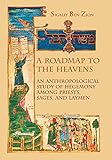A Roadmap to the Heavens : An Anthropological Study of Hegemony among Priests, Sages, and Laymen / Sigalit Ben-Zion.
Material type: TextSeries: Judaism and Jewish LifePublisher: Boston, MA : Academic Studies Press, [2008]Copyright date: ©2008Description: 1 online resource (364 p.)Content type:
TextSeries: Judaism and Jewish LifePublisher: Boston, MA : Academic Studies Press, [2008]Copyright date: ©2008Description: 1 online resource (364 p.)Content type: - 9781934843147
- 9781618110374
- 305.50933 22
- BM720.C65 B46 2009
- online - DeGruyter
| Item type | Current library | Call number | URL | Status | Notes | Barcode | |
|---|---|---|---|---|---|---|---|
 eBook
eBook
|
Biblioteca "Angelicum" Pont. Univ. S.Tommaso d'Aquino Nuvola online | online - DeGruyter (Browse shelf(Opens below)) | Online access | Not for loan (Accesso limitato) | Accesso per gli utenti autorizzati / Access for authorized users | (dgr)9781618110374 |
Frontmatter -- CONTENTS -- FOREWORD -- ACKNOWLEDGMENTS -- CHAPTER ONE. Introduction and methodological considerations -- CHAPTER TWO. Mapping the social identity “Priests” -- CHAPTER THREE. Mapping the social identity “Sages” -- CHAPTER FOUR. The relationship between the Haverim and ‘Am ha’aretz -- CHAPTER FIVE. The self-awareness of the Sages as constituters of the counter-hegemony -- CHAPTER SIX. Exchange of ruling elites or the constitution of counter-hegemony? -- SUMMARY AND CONCLUSIONS -- AFTERWORD -- GLOSSARY OF HEBREW TERMS -- TRANSLATION OF PRIMARY SOURCES -- BIBLIOGRAPHY -- INDEX OF REFERENCES -- INDEX OF CONCEPTS -- INDEX OF NAMES
restricted access online access with authorization star
http://purl.org/coar/access_right/c_16ec
A Roadmap to the Heavens challenges readers to rethink prevailing ideas about the social map of Jewish society during the Tannaitic period (70 C.E. – 220 C.E.). New insights were made possible by applying anthropological theories and conceptual tools. In addition, social phenomena were better understood by comparing them to similar social phenomena in other cultures regardless of time and space. The book explores the rich and complex relationships between the Sages, Priests, and laymen who competed for hegemony in social, cultural, and political arenas. The struggle was not simply a case of attempting to displace the priestly elite by a new scholarly elite. Rather, in the process of constituting a counter-hegemony, the attitude of the Sages towards the Priests entailed ambivalent psychological mechanisms, such as attraction – rejection, imitation – denial, and cooperation – confrontation. The book further reveals that to achieve political and social power the Sages used the established hegemonic priestly discourse to undermine the existing social structure. The innovative discovery of this monograph is that while the Sages professed a new social order based on intellectual achievement, they retained elements of the old order, such as family attribution, group nepotism, endogamy, ritual purity and impurity, and secret knowledge. Thus, social mobility based on education was available only to privileged social classes. The conclusion of the book is that even though the Sages resisted the priestly hegemony and attempted to disengage from it, they could not free themselves from the shackles of the priestly discourse and praxis.
Mode of access: Internet via World Wide Web.
In English.
Description based on online resource; title from PDF title page (publisher's Web site, viewed 01. Dez 2022)


